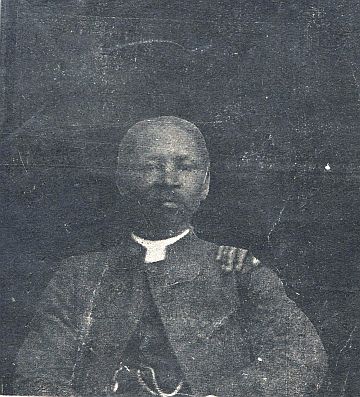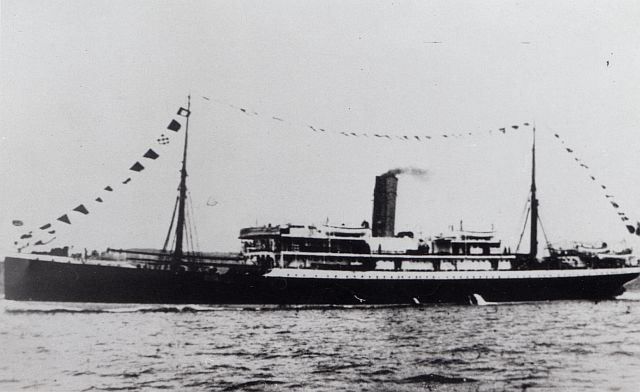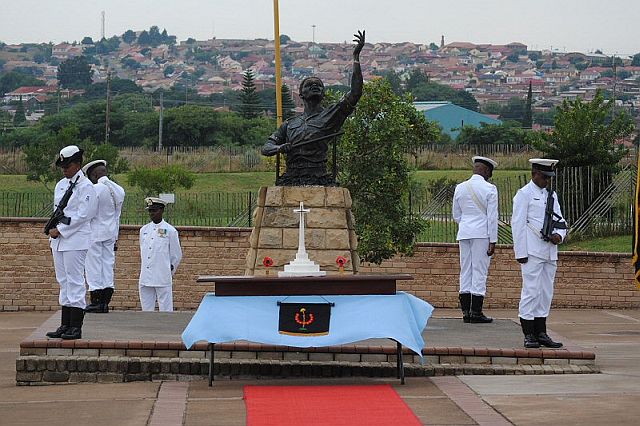

 The South African
The South African
'Be quiet and calm, my Countrymen, for what is taking place now is what you came here to do. We are all going to die, and that is what we came here for. Brothers, we are drilling the death drill. I, a Zulu, say here and now that you are all my brothers ... Xhosas, Swazis, Pondos, Basotho and all others, let us die like warriors. We are the sons of Africa. Raise your war cries, my brothers, for though they made us leave our assegais back in the kraals, our voices are left with our bodies ... ' The words attributed to the Reverend Isaac Wauchope Dyobha on board the Mendi, 21 February 1917.

The Reverend Isaac Wauchope Dyobha
Photos by courtesy DNMMH
The sinking of SS Mendi early on the morning of 21 February 1917 is one of the three iconic South African events of the First World War. The other two events are Delville Wood (15-21 July 1916) and Square Hill (20 September 1918). SS Mendi left Cape Town on 16 January 1917 with the 5th Battalion, South African Native Labour Contingent (SANLC), on board. During the 34 day voyage, she stopped at Lagos, Nigeria and Freetown, Sierra Leone, for coal and stores. She arrived at Plymouth on 19 February 1917 and landed Royal Flying Corps recruits and military passengers. SS Mendi sailed from Plymouth on the afternoon of 20 February 1917, en route for Le Havre, France. At 04.57 am on 21 February 1917, she was rammed by the much larger SS Darro at the junction between her two forward holds. She sank in 25 minutes. During this time, according to strong oral tradition, some of the men of the 5th Battalion performed the 'Death Dance'. According to Norman Clothier, author of Black Valour, 607 black soldiers died that night, together with two of their white officers, seven white NCOs and 31 of the Mendi's crew.
The Death Dance revisited
We are fast approaching the centenary of one of the most tragic events in South African military history - the sinking of the SS Mendi. An iconic facet of the tragedy is the legend of Death Dance. Its status as a legend has cast doubt on whether it actually took place. Yet, a notable aspect of this controversy is that the doubters' views of the legend tell us more about themselves than the veracity of the legend itself. A key issue is their position on oral evidence and tradition. It was only long after the event, in the 1960s and 1970s, that oral history really started to be accepted (ENWikipedia. org/wiki/Oral_history retrieved 17 October 2016).
This development has considerable significance because, as Pieter Geyl noted in Napoleon: For and Against, the period in which an historical account is written has a significant impact on the perspective from which it is written. From this, we can similarly deduce that the period during which an historian lives will also have a significant impact on his or her perspective. One could expect that historians trained in the 1960s and early 1970s, at a time when oral history was only beginning to be accepted as a source of evidence, might be less comfortable with it than those trained later. If an historian writing in this period has problems with oral history, then it follows that he or she would also struggle to deal with oral tradition.

SS Mendi
The principal obstacle in accepting oral tradition as a source of historical evidence is determining the accuracy of its transmission. This creates a psychological barrier, which can be seen in the earlier works by Bill Nasson, Springboks on the Somme (2007), and Albert Grundlingh, Fighting their own war: South African Blacks and the First World War (1987). In handling the sinking of the Mendi, Professor Grundlingh places more faith in a newspaper report written fifty years after the event, than in an eye witness account, which he dismisses on the grounds that Hertslet, the medical officer giving the account, having trained the men, would have liked to believe that they behaved well. Yet, the only training he would have done is perhaps first aid. As the medical officer, he would have been more independent than the officers in the chain of command. This is a cheap shot at the officers of the 5th Battalion, South African Native Labour Contingent on board the ship, attacking the courage of the men of the battalion (Grundlingh, 1987 pp 93-6).
Grundlingh (1987, pp 139-41) suggests that the idea of the Death Dance only gained prominence in the 1940s, but he does so using a 1950s newspaper as evidence. His reliance on a newspaper article over an oral history account included in his bibliography and his attribution of the story as a nationalist construct, shows a discomfort with both oral history and oral tradition. Similarly, Professor Nasson approaches the subject with caution by using the word 'supposedly' (Nasson, 2007, p168-9). More significantly, Nasson (2007, p222) reveals that, even in 1917, black newspaper editors certainly believed or may have known that most of the men of the Mendi had died courageously.
In his more recent book, WW1 and the People of South Africa (2014), Professor Nasson refers to Norman Clothier's Black Valour as a pioneering study. Norman Clothier was a veteran of the Second World War and his book identified the First World War members of the SANLC as individuals. Ordinary soldiers, irrespective of their background, want others to think well of themselves. This is an aspect which is conspicuously lacking in scholarly accounts. The earliest account of the Death Dance discovered by Norman Clothier (1987, p 182) appears to be in South Africa Fights, published in 1941.

A commemorative service at the Mendi Memorial, Atteridgeville, Tshwane
In the library at Ditsong National Museum of Military History is a copy of the 1932 Mendi Memorial Herald, which was published in Johannesburg by the Mendi Memorial Committee. Significantly, Isaac Wauchope Dyobha's picture appears on the cover. He is described as the Reverend I Wauchope. This is nine years before Simpson captured the story in South Africa Fights, and it shows that Isaac Wauchope Dyobha was already then an acknowledged leader in the Mendi saga. What is remarkable about Simpson's account is that he elevates the Mendi sinking to the level of the battles of Delville Wood and Square Hill. This link is significant. Although the account is embellished and Isaac Wauchope Dyobha is described as a Zulu, there are compelling reasons for believing it. South Africa Fights has, as part of its purpose, propaganda. However, the truth is the most powerful propaganda. It is unlikely that Simpson would have risked undermining the thrust of his book by using an account without a solid foundation. When one examines the evidence relating to the sinking of the SS Mendi held in the archives of Ditsong National Museum of Military History, it is interesting to note that oral tradition is strongly represented in the veterans' publications.
Is the story of the Death Dance on the Mendi a case of solid, indigenous tradition? A reading of The Invention of Tradition (Cambridge University Press, Cambridge, 1983), edited by Eric Hobsbawm and Terence Ranger, suggests that this is so. Nowhere in Ranger's chapter in this book is there an example which matches the Mendi in the constructed traditions (Ranger, 1983, pp 211-262).
In organising the Death Dance, Dyobha appealed to two characteristics in the men - their sense of comradeship and their self-identity as warriors. Linked to this is the crucial consideration that for an individual soldier the good opinion of his immediate comrades is very important. The men of the 5th Battalion SANLC perceived themselves and their comrades to be warriors. A warrior does not behave like a frightened child. The appeal went beyond comradeship to one of family honour.
The power of the words attributed to Dyobha on that fateful morning is an authoritative argument in favour of their authenticity. A speech like that is very difficult to compose in the quiet of an office or home room. It fits far better alongside many a battlefield exhortation. The dance, as an act of defiance, has primeval origins (Young 1991 pp 93-123), reinforcing the likelihood that men facing death would have danced their defiance.
There is a strong case for the use of oral tradition as a source of evidence in historical research. A good example of its use can be found in Early Iron Age Greek Warfare 11000-700 BC (Osprey, Oxford, 2016). Thus, for someone comfortable with oral history and oral tradition, the answer to the question posed by the play Did We Dance? is 'yes'. It is reasonable to accept that some of the warrior-soldiers of the 5th Battalion did dance or drill as the ship went down, as Simpson's account would have us believe. There is no reason to disregard black newspapermen who, by July 1917, already either believed or knew of the courage of the men of the Mendi. What we must never forget is that ordinary soldiers like to think well of themselves.
Bibliography
Return to Journal Index OR Society's Home page
South African Military History Society / scribe@samilitaryhistory.org